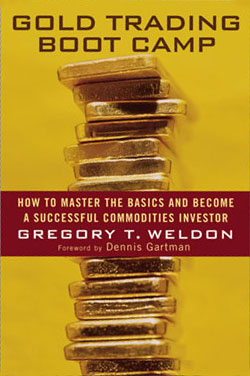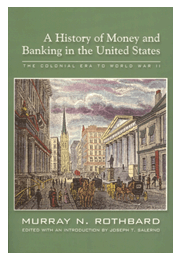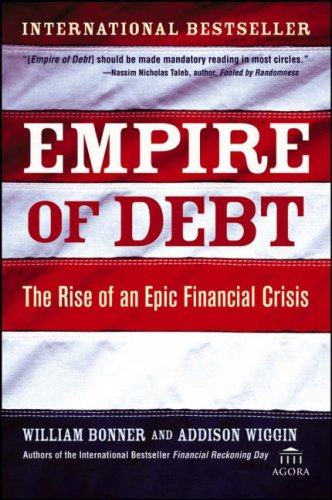
Gold Trading Boot Camp: How to Master the Basics and Become a Successful Commodities Investor
By Gregory T. Weldon
John Wiley and Sons 2007
348 pages. $34.95
David Byrne was the front man for an alternative rock band called the Talking Heads. A genius, Byrne had a knack for writing superlative lyrics. Lyrics that made the listener stop and think. For example:
“And you may ask yourself, Am I right … Am I wrong?”
Commodity investors all over the world ask themselves the same question every day. And with good reason, for they’re risking their financial future on the answer to the question.
Gregory Weldon is the front man for Weldon Financial. And like David Byrne he has a knack for writing. Only Weldon doesn’t write lyrics. He writes investment advice – how-to-stuff. He wrote Gold Trading Boot Camp, which is a remarkable book. It’s remarkable because it not only offers sound investment guidance, but does it in a very lively manner. Reading Gold Trading Boot Camp is akin to reading history, comedy, memoir, and economics all rolled up into one splendid book.
Gold Trading Boot Camp is divided into eight parts. Part One is entitled ‘Evolution of a Trader.’ In short, it’s about the author’s introduction to the world of commodity trading. And like Daniel in the Lion’s Den, Weldon had to learn fast if he wanted to avoid being eaten alive. There are many humorous anecdotes, which are fun to read. But there’s also a point. And the point is this: “to relate how I formed, cultivated and evolved my methodology” of investing.
Part Two is about the ‘Macromonetary Era.’ As Weldon explains, “Gold is at the top of the pyramid. The U.S. dollar gets the second spot, thanks to its still undisputed reign as King-Dollar.” Weldon then states, “Someday things will change.” This change will occur due to the economic Never Never Land the world is now living in. When they do change, he believes there will be only two options. “Facilitate a recession” and pay down the massive debt or “facilitate a reflation” by attempting to bail out the economy “with even cheaper liquidity.” According to Weldon, when that day arrives, “the Emperor will be wearing no clothes.” That’s the day you want to own gold.
In Part Three, Weldon takes a look inside the market. Which means that as a trader he wants the big-picture. He examines everything and explains to the reader how he does it. The goal is to analyze “the macropuzzle,” and then “stack one clue on top of another clue.” In the end, the accumulating clues allow the investor to identify “a market trend.” Once a trend is distinguished, then the investor can “commit risk capital to that trend.”
‘Looking Inside the Market Technically’ is the title of Part Four. Wherein, Weldon states, “It is critical to maintain a standard technical overlay, simply because the markets evolve.” This standardizing technique works because the factor that does not change is “the human condition.” And this unchanging factor allows for the identification of macrotrends. Weldon discusses the tools he uses to identify trends: charts, moving averages, oscillators, rate-of-change indicators, Fibonacci retracements, and volume. Which all sounds like advanced rocket science, but Weldon describes how he does it and keeps it as simple as adding two plus two. This section of the book is truly illuminating.
In Part Five, Weldon moves on to explain how he analyzes macroeconomic fundamentals. This type of analysis is done from the bottom up, because “evidence of a potential shift in trend first” appears “at the bottom and evolves upward.” And once again, it involves routine analysis of an ocean of data. Which means that smart investing is nothing more or less than hard work.
Part Six is one of the most interesting sections of Gold Trading Boot Camp. For it is here that Weldon explains how he takes the results of his analysis and identifies trends. Weldon says, “That the majority of profits have come when markets are trending.” In other words, if you want to make money – and who doesn’t? – you need to know how to spot trends. To that end, Weldon provides ‘trend identification techniques,’ which include momentum, timing, and trading the trend. He presents his TIMID Matrix, which is a fascinating concept. But, unfortunately, he does not share the algorithms he uses to calculate TIMID indicators. His conclusion is that “right now, the market is going nowhere fast amid a lack of clarity in the macroscene.”
‘Defining and Managing Risk’ is the topic of Part Seven. Weldon starts out by stating, “A discussion of risk analysis must begin at the top-down portfolio level.” He then breaks risk analysis down into diversity, position leverage, trade risk, correlated risk, sector risk, and psychological risk. Each of these constituents of risk is clearly explained. Weldon’s goal in risk analysis is to avoid gambling. By using a strategic approach composed of macro-analysis, psychology, technical overlays, and a risk management protocol, the odds are in his favor. As Weldon says, “I trade and invest on a strategic basis. I do not gamble.”
The final section of the book – ‘Putting It All Together’ – falls just a tad flat. Primarily, because Weldon doesn’t put it all together. He merely says, “If all the macro and technical factors are aligned, then the assumption of capital risk becomes an option, and a trade or investment is warranted.” Instead, he should have pointed out that his macro-style of trading, while heavily reliant on technical data and its subsequent analysis, also relies on intuition in the best sense of the word. And this intuition or insight can’t be taught. It is the product of years of experience. In other words, trading is a science as well as an art.
That being said, any investor wanting to gain such insight requires the right tools to begin his apprenticeship. Weldon provides the tools in Gold Trading Boot Camp. He tells you how you too can eventually become a Master of the Universe. And he does so with enthusiasm, in an engaging and entertaining style. And enthusiasm is a quality even rarer than gold.
![]() On the Read-O-Meter, which ranges from 1 star (really bad) to 5 stars (really good), Gold Trading Boot Camp trades 5 stars.
On the Read-O-Meter, which ranges from 1 star (really bad) to 5 stars (really good), Gold Trading Boot Camp trades 5 stars.



